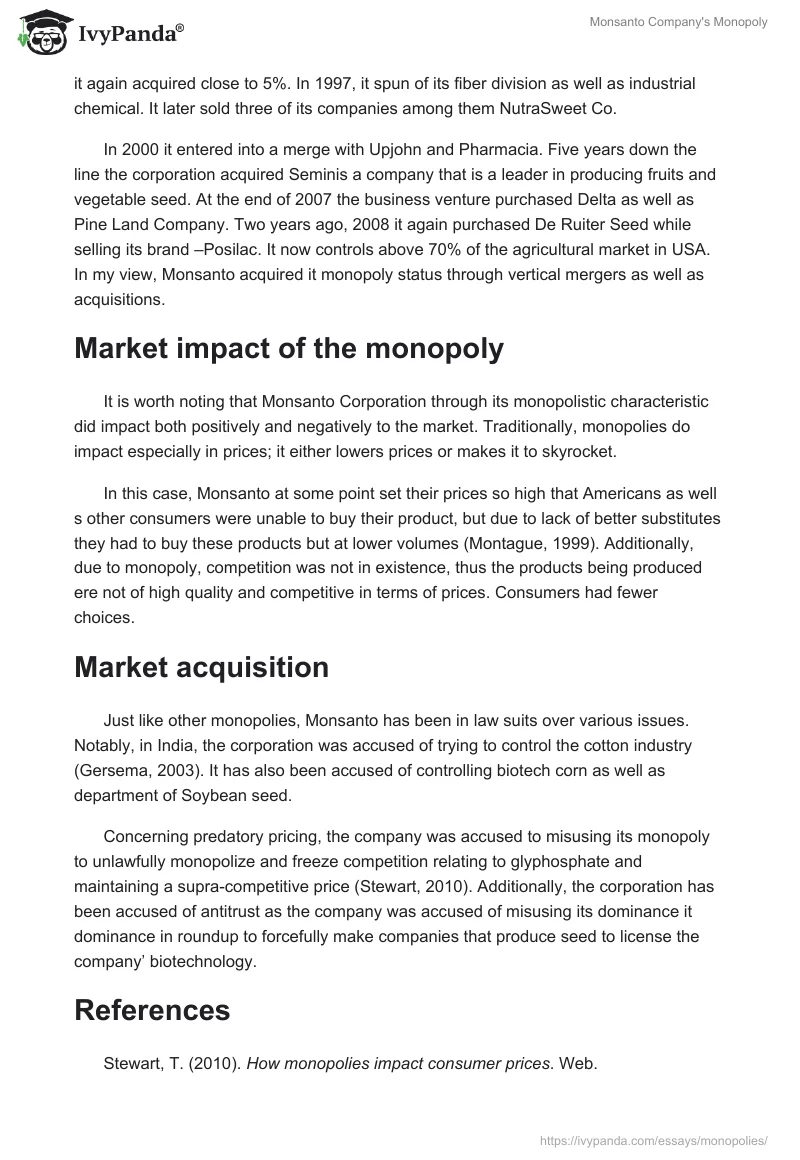Introduction
The essay is an over view of monopoly. The chosen company or organization for the purposes of this study is Monsanto a company that holds about 70% to 100% of the market in commercial seed. It is well known for producing herbicide roundup, pesticide, crop seeds and it was sued by those organizations that compete with it for monopolistic practices as well as anti-trust.
The company was founded in 1901 and headquartered at Creve Coeur, Missouri in United States of America. It employs slightly over 21,000 as at 2009. In 2008 its revenue and net income stood at $11.37 and $2.02 billion.
Economists coined the term monopoly to refers to an existing situations whereby a particular person or an organization do have adequate say or control concerning given goods or services thus determining as well as dictating the conditions or terms under which consumers as well as other persons will have the potential to land their hands on such goods or services. There are four main characteristics of monopoly, single seller, market power, price discrimination as well as firm and industry.
History of Monsanto
It was founded in 1901 and well known as a multinational corporation that leads in biotechnology in the field of agriculture; additionally it produces genetically engineered seed. 18 years down the line, it partnered with Grasser’s Chemical Works thereby expanding its business in Europe. It later grew to produce industrial chemicals. In 1940 the company became well known in producing plastic. Four years later it started producing DDT bit was later banned, in 1949the corporation acquired the American Viscose (Julfekar, 2010).
Five years down the line it joined hands with Bayer to engage in Polyurethanes in United States of America. The corporation bought G.D Searle &Company. It is important noting that, 11 years later, it acquired 49.9% of Calgene and before the end of that year, it again acquired close to 5%. In 1997, it spun of its fiber division as well as industrial chemical. It later sold three of its companies among them NutraSweet Co.
In 2000 it entered into a merge with Upjohn and Pharmacia. Five years down the line the corporation acquired Seminis a company that is a leader in producing fruits and vegetable seed. At the end of 2007 the business venture purchased Delta as well as Pine Land Company. Two years ago, 2008 it again purchased De Ruiter Seed while selling its brand –Posilac. It now controls above 70% of the agricultural market in USA. In my view, Monsanto acquired it monopoly status through vertical mergers as well as acquisitions.
Market impact of the monopoly
It is worth noting that Monsanto Corporation through its monopolistic characteristic did impact both positively and negatively to the market. Traditionally, monopolies do impact especially in prices; it either lowers prices or makes it to skyrocket.
In this case, Monsanto at some point set their prices so high that Americans as well s other consumers were unable to buy their product, but due to lack of better substitutes they had to buy these products but at lower volumes (Montague, 1999). Additionally, due to monopoly, competition was not in existence, thus the products being produced ere not of high quality and competitive in terms of prices. Consumers had fewer choices.
Market acquisition
Just like other monopolies, Monsanto has been in law suits over various issues. Notably, in India, the corporation was accused of trying to control the cotton industry (Gersema, 2003). It has also been accused of controlling biotech corn as well as department of Soybean seed.
Concerning predatory pricing, the company was accused to misusing its monopoly to unlawfully monopolize and freeze competition relating to glyphosphate and maintaining a supra-competitive price (Stewart, 2010). Additionally, the corporation has been accused of antitrust as the company was accused of misusing its dominance it dominance in roundup to forcefully make companies that produce seed to license the company’ biotechnology.
References
Stewart, T. (2010). How monopolies impact consumer prices. Web.
Montague, P. (1999). Monsanto: The Bad Seed. Environmental Health Weekly, 21(6), 2-16.
Gersema, E. (2003). Death Sentence for Monsanto–Roundup Resistant Weeds. Associated Press.
Julfekar H. (2010). Types of Monopoly. Web.


